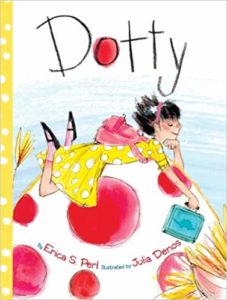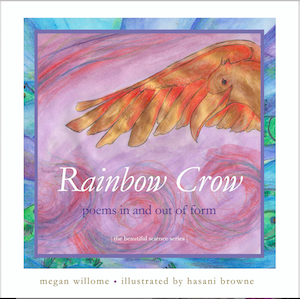The difference between fiction and reality? Fiction has to make sense.”
—Tom Clancy, author
As you go about your day, meeting people you know and people you don’t, picture each person holding a colored string, and pretend that each string is attached to an imaginary animal friend.
What? You say imaginary friends aren’t real? Are you sure? Are you positive there aren’t monsters under the bed? Gnomes in the garden? Fairies upsetting your dishwasher?
Callie Feyen introduced me to Dotty, a book about imaginary friends, by Erica S. Perl. The assignment in our workshop was to describe how Ida (the main character) and Dotty (her imaginary friend) are both heroines. I wrote about a different heroine in the story — Ms. Raymond (the teacher). A case can be made for all three of them. It is interesting that the one who gets billing in the title is Dotty.

What is Dotty? Hard to say. She’s white with red polka-dots. She has pink horns with purple stipes. A butterfly perches on her nose. She is enormous, like a curiously bovine guardian angel. She accompanies Ida to school. Her presence is not an entirely unusual in a story about a child going off to preschool or kindergarten.
But this story veers in a delightful way when we see that all the children in the classroom have imaginary animal friends and they are all, like Dotty, similarly unusual. I can tell you what each imaginary animal looks like but not what they are. We readers have to get to know them and their people.
The brilliance of this story is that there is another imaginary friend: Gert. If you look closely at the illustrations by Julia Denos, you’ll see Gert before you meet — her? him? they? It’s unclear and unimportant. But it is important to notice that Gert has four legs and a long neck. It’s yellow with brown stripes, tall ears, and striking eyelashes. It might be shy because it’s always hiding behind the coat rack, behind someone’s brown plaid coat. Gert is attached to its owner by a red string, which contrasts with the blue string Ida uses to keep close to Dotty.
After an argument with a student named Katya, Dotty gets protective of Ida, and the blue string falls out of her hand. For the rest of the story, Dotty is pictured outside the classroom, on a green hill. I want her to moo, but she is quiet, waiting for Ida, who hugs her at the end of the day and picks up her blue string again. I wonder if after this story concludes, Dotty will still accompany Ida to school but remain outside, quietly munching grass.
Author Erica S. Perl has also written chapter books and novels for a young audience. Her book All Three Stooges won the 2018 National Jewish Book Award for Children’s Literature. Illustrator Julia Denos is also an author herself. If you happen to be at the Eric Carle Museum in Amherst, Massachusetts, on Sunday, December 8, at 2 p.m., she and illustrator E.B. Goodale are doing an event about their recent book Here and Now.
There are a couple of illustrations in Dotty which show the students with their animal friends, and it struck me that every child comes to school with something unseen. It might not be a Dotty, attached to an Ida, holding a blue string. But children are not blank slates at the ripe old age of 5. They bring their small lifetimes of experiences and relationships with them. Their lines between fiction and reality are almost indistinguishable.
And we grownups? We’re not always so good at distinguishing between the two either. We come to our classrooms and our jobs and our families with our own bizarre perceptions. If we remember that everyone else does too, we might show each other the same kindness that Ms. Raymond shows Ida. Our Dottys might find safe green spaces to rest.
For You
1. Did you or a child you love have an imaginary friend? Describe it.
2. Make up a story about a stranger on an airplane or a subway or in a café. Or about their unusual friend.
3. What color string would you use to keep your imaginary friend nearby?
_______________
It’s snow time! The next Children’s Book Club will meet Friday, December 13. We will read Dream Snow by Eric Carle.
Photo by Tambako The Jaguar, Creative Commons, via Flickr. Post by Megan Willome.
Browse more Children’s Book Club
“Megan Willome has captured the essence of crow in this delightful children’s collection. Not only do the poems introduce the reader to the unusual habits and nature of this bird, but also different forms of poetry as well.”
—Michelle Ortega, poet and children’s speech pathologist
- Perspective: The Two, The Only: Calvin and Hobbes - December 16, 2022
- Children’s Book Club: A Very Haunted Christmas - December 9, 2022
- By Heart: ‘The night is darkening round me’ by Emily Brontë - December 2, 2022



L.L. Barkat says
Thread. Golden, I think. Or, invisible, but then turns gold when someone thinks good thoughts about someone else. And then my imaginary friend looks like clouds doing soft somersaults, and I get tugged along (happily) by my golden-invisible thread. 🙂
Megan Wilome says
That sounds about right.
Will Willingham says
“Every child comes to school with something unseen.”
Oh gosh, don’t they.
Sounds like a wonderful story I may need to look up. 🙂
Megan Willome says
I had never heard of this one either, but I’ve bought a copy to give to someone who is going to be a teacher.
Sandra Heska King says
“. . . every child comes to school with something unseen . . . everyone else does, too.”
I don’t remember ever having an imaginary friend.
“As you go about your day, meeting people you know and people you don’t, picture each person holding a colored string, and pretend that each string is attached to an imaginary animal friend.”
Maybe I should create one–like a shadow. Or a love-everyone dog. Maybe rainbow colored. I would name it kindness. It would trail a red thread–of hope–that would catch the thread of all sorrows.
Today I’m cleaning up my office that has suffered greatly over the spring/summer/so-far-fall. I’m reorganizing books, making room to get back to work. Not sure I can handle another book, but…
Megan Willome says
Sandy, I think you have perfectly described what your imaginary friend would look like.
Knowing that you’re in cleaning mode, I recommend requesting this one from your library. It will take you five minutes to read and several hours to ponder.